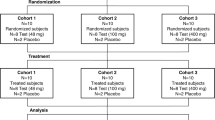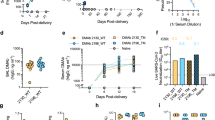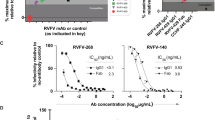Abstract
Antibodies against the toxin portion of recombinant immunotoxins (RIT) reduce their efficacy and pose a potential safety risk. To overcome this problem we mutated the very immunogenic immunotoxin SS1P to produce LMB-T20, a de-immunized RIT that has the eight human T-cell epitopes in SS1P modified or removed. To determine the effect of T-cell epitope removal in vivo we mapped the T-cell epitopes in immune-competent BALB/c mice and found that these mice recognize two epitopes. One corresponds to the human immunodominant T-cell epitope and the other to a human subdominant epitope; both were eliminated in LMB-T20. We found that mice immunized with LMB-T20 did not have T-cell activation and did not develop anti-drug antibodies (ADA), whereas mice immunized with SS1P, showed T-cell activation, and developed ADA detected by both ELISA and drug neutralizing assays. The ability of the mice treated with LMB-T20 to respond to other antigens was not compromised. We conclude that elimination of T-cell epitopes is sufficient to prevent formation of antibodies to an immunogenic foreign protein.
This is a preview of subscription content, access via your institution
Access options
Subscribe to this journal
Receive 12 digital issues and online access to articles
$119.00 per year
only $9.92 per issue
Buy this article
- Purchase on Springer Link
- Instant access to full article PDF
Prices may be subject to local taxes which are calculated during checkout







Similar content being viewed by others
References
Casadevall N, Nataf J, Viron B, Kolta A, Kiladjian JJ, Martin-Dupont P et al. Pure red-cell aplasia and antierythropoietin antibodies in patients treated with recombinant erythropoietin. N Engl J Med 2002; 346: 469–475.
Chung CH, Mirakhur B, Chan E, Le QT, Berlin J, Morse M et al. Cetuximab-induced anaphylaxis and IgE specific for galactose-alpha-1,3-galactose. N Engl J Med 2008; 358: 1109–1117.
Schellekens H . How to predict and prevent the immunogenicity of therapeutic proteins. Biotechnol Annu Rev 2008; 14: 191–202.
Kreitman RJ, Tallman MS, Robak T, Coutre S, Wilson WH, Stetler-Stevenson M et al. Phase I trial of anti-CD22 recombinant immunotoxin moxetumomab pasudotox (CAT-8015 or HA22) in patients with hairy cell leukemia. J Clin Oncol 2012; 30: 1822–1828.
Hassan R, Sharon E, Thomas A, Zhang J, Ling A, Miettinen M et al. Phase 1 study of the antimesothelin immunotoxin SS1P in combination with pemetrexed and cisplatin for front-line therapy of pleural mesothelioma and correlation of tumor response with serum mesothelin, megakaryocyte potentiating factor, and cancer antigen 125. Cancer 2014; 120: 3311–3319.
Singh R, Zhang Y, Pastan I, Kreitman RJ . Synergistic antitumor activity of anti-CD25 recombinant immunotoxin LMB-2 with chemotherapy. Clin Cancer Res 2012; 18: 152–160.
Weldon JE, Pastan I . A guide to taming a toxin--recombinant immunotoxins constructed from Pseudomonas exotoxin A for the treatment of cancer. FEBS J 2011; 278: 4683–4700.
Hassan R, Bullock S, Premkumar A, Kreitman RJ, Kindler H, Willingham MC et al. Phase I study of SS1P, a recombinant anti-mesothelin immunotoxin given as a bolus I.V. infusion to patients with mesothelin-expressing mesothelioma, ovarian, and pancreatic cancers. Clin Cancer Res 2007; 13: 5144–5149.
Kreitman RJ, Hassan R, Fitzgerald DJ, Pastan I . Phase I trial of continuous infusion anti-mesothelin recombinant immunotoxin SS1P. Clin Cancer Res 2009; 15: 5274–5279.
Mazor R, Eberle JA, Hu X, Vassall AN, Onda M, Beers R et al. Recombinant immunotoxin for cancer treatment with low immunogenicity by identification and silencing of human T-cell epitopes. Proc Natl Acad Sci USA 2014; 111: 8571–8576.
Harding FA, Liu AD, Stickler M, Razo OJ, Chin R, Faravashi N et al. A beta-lactamase with reduced immunogenicity for the targeted delivery of chemotherapeutics using antibody-directed enzyme prodrug therapy. Mol Cancer Ther 2005; 4: 1791–1800.
Cantor JR, Yoo TH, Dixit A, Iverson BL, Forsthuber TG, Georgiou G . Therapeutic enzyme deimmunization by combinatorial T-cell epitope removal using neutral drift. Proc Natl Acad Sci USA 2011; 108: 1272–1277.
Moise L, Song C, Martin WD, Tassone R, De Groot AS, Scott DW . Effect of HLA DR epitope de-immunization of Factor VIII in vitro and in vivo. Clin Immunol 2012; 142: 320–331.
Cizeau J, Grenkow DM, Brown JG, Entwistle J, MacDonald GC . Engineering and biological characterization of VB6-845, an anti-EpCAM immunotoxin containing a T-cell epitope-depleted variant of the plant toxin bouganin. J Immunother 2009; 32: 574–584.
Salvat RS, Choi Y, Bishop A, Bailey-Kellogg C, Griswold KE . Protein deimmunization via structure-based design enables efficient epitope deletion at high mutational loads. Biotechnol Bioeng 2015; 112: 1306–1318.
De Groot AS, Martin W . Reducing risk, improving outcomes: bioengineering less immunogenic protein therapeutics. Clin Immunol 2009; 131: 189–201.
Tangri S, Mothe BR, Eisenbraun J, Sidney J, Southwood S, Briggs K et al. Rationally engineered therapeutic proteins with reduced immunogenicity. J Immunol 2005; 174: 3187–3196.
Baker MP, Reynolds HM, Lumicisi B, Bryson CJ . Immunogenicity of protein therapeutics: The key causes, consequences and challenges. Self Nonself 2010; 1: 314–322.
Mazor R, Vassall AN, Eberle JA, Beers R, Weldon JE, Venzon DJ et al. Identification and elimination of an immunodominant T-cell epitope in recombinant immunotoxins based on Pseudomonas exotoxin A. Proc Natl Acad Sci USA 2012; 109: E3597–E3603.
Mazor R, Zhang J, Xiang L, Addissie S, Awuah P, Beers R, et al. Recombinant immunotoxin with T cell epitope mutations that greatly reduce immunogenicity for treatment of mesothelin expressing tumors. Mol Cancer Ther in press.
Pastan I, Beers R, Bera TK . Recombinant immunotoxins in the treatment of cancer. Methods Mol Biol 2004; 248: 503–518.
Liu W, Onda M, Lee B, Kreitman RJ, Hassan R, Xiang L et al. Recombinant immunotoxin engineered for low immunogenicity and antigenicity by identifying and silencing human B-cell epitopes. Proc Natl Acad Sci USA 2012; 109: 11782–11787.
Brocke S, Dayan M, Rothbard J, Fuchs S, Mozes E . The autoimmune response of different mouse strains to T-cell epitopes of the human acetylcholine receptor alpha subunit. Immunology 1990; 69: 495–500.
Yeung VP, Chang J, Miller J, Barnett C, Stickler M, Harding FA . Elimination of an immunodominant CD4+ T cell epitope in human IFN-beta does not result in an in vivo response directed at the subdominant epitope. J Immunol 2004; 172: 6658–6665.
Brinks V, Jiskoot W, Schellekens H . Immunogenicity of therapeutic proteins: the use of animal models. Pharm Res 2011; 28: 2379–2385.
van Beers MM, Sauerborn M, Gilli F, Hermeling S, Brinks V, Schellekens H et al. Hybrid transgenic immune tolerant mouse model for assessing the breaking of B cell tolerance by human interferon beta. J Immunol Methods 2010; 352: 32–37.
Mazor R, Tai CH, Lee B, Pastan I . Poor correlation between T-cell activation assays and HLA-DR binding prediction algorithms in an immunogenic fragment of Pseudomonas exotoxin A. J Immunol Methods 2015; in press.
Vita R, Overton JA, Greenbaum JA, Ponomarenko J, Clark JD, Cantrell JR et al. The immune epitope database (IEDB) 3.0. Nucleic Acids Res 2015; 43: D405–D412.
Weldon JE, Xiang L, Chertov O, Margulies I, Kreitman RJ, FitzGerald DJ et al. A protease-resistant immunotoxin against CD22 with greatly increased activity against CLL and diminished animal toxicity. Blood 2009; 113: 3792–3800.
Wang P, Sidney J, Dow C, Mothe B, Sette A, Peters B . A systematic assessment of MHC class II peptide binding predictions and evaluation of a consensus approach. PLoS Comput Biol 2008; 4: e1000048.
Delluc S, Ravot G, Maillere B . Quantitative analysis of the CD4 T-cell repertoire specific to therapeutic antibodies in healthy donors. FASEB J 2011; 25: 2040–2048.
Onda M, Nagata S, FitzGerald DJ, Beers R, Fisher RJ, Vincent JJ et al. Characterization of the B cell epitopes associated with a truncated form of Pseudomonas exotoxin (PE38) used to make immunotoxins for the treatment of cancer patients. J Immunol 2006; 177: 8822–8834.
Onda M, Beers R, Xiang L, Lee B, Weldon JE, Kreitman RJ et al. Recombinant immunotoxin against B-cell malignancies with no immunogenicity in mice by removal of B-cell epitopes. Proc Natl Acad Sci USA 2011; 108: 5742–5747.
Paul W . Fundamental Immunology. 6th ed. Philadelphia, PA: Lippincott Willians & Wilkins, 2008.
Shankar G, Pendley C, Stein KE . A risk-based bioanalytical strategy for the assessment of antibody immune responses against biological drugs. Nat Biotechnol 2007; 25: 555–561.
Chirmule N, Jawa V, Meibohm B . Immunogenicity to therapeutic proteins: impact on PK/PD and efficacy. AAPS J 2012; 14: 296–302.
U.S. Department of Health and Human Services Food and Drug Administration. Guidance for industry immunogenicity assessment for therapeutic protein products. Silver Spring, MD: Center for Drug Evaluation and Research; 2014.
U.S. Department of Health and Human Services Food and Drug Administration. Guidance for Industry Assay Development for Immunogenicity Testing of Therapeutic Proteins. Silver Spring, MD: Center for Drug Evaluation and Research; 2009.
Acknowledgements
The authors thank Dr. Chin-Hsien Tai for creating the structural model of RIT for figure 1. Supplementary information of this article can be found on the Cellular & Molecular Immunology’s website (http://www.nature.com/cmi).
Author information
Authors and Affiliations
Corresponding author
Additional information
Supplementary information of this article can be found on the Cellular & Molecular Immunology’s website (http://www.nature.com/cmi).
Supplementary information
Rights and permissions
About this article
Cite this article
Mazor, R., Crown, D., Addissie, S. et al. Elimination of murine and human T-cell epitopes in recombinant immunotoxin eliminates neutralizing and anti-drug antibodies in vivo. Cell Mol Immunol 14, 432–442 (2017). https://doi.org/10.1038/cmi.2015.91
Received:
Revised:
Accepted:
Published:
Issue Date:
DOI: https://doi.org/10.1038/cmi.2015.91



